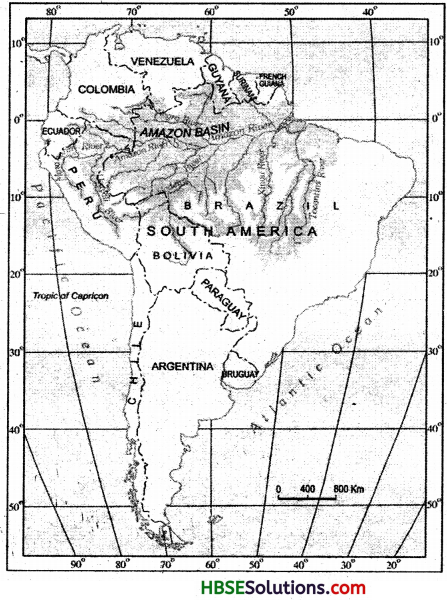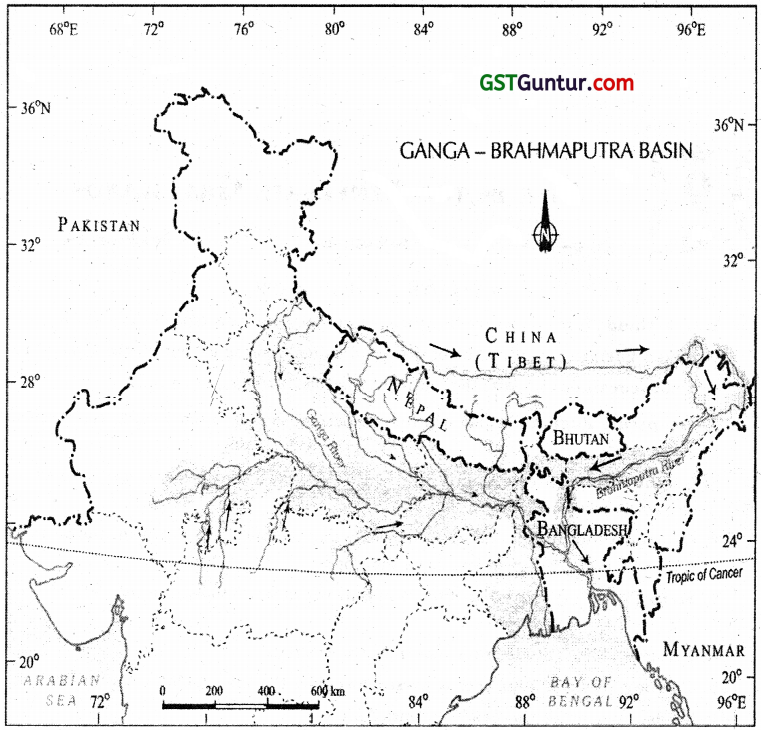Haryana State Board HBSE 7th Class Social Science Solutions Geography Chapter 8 Human Environment Interactions: The Tropical and the Subtropical Regions Textbook Exercise Questions and Answers.
Haryana Board 7th Class Social Science Solutions Geography Chapter 8 Human Environment Interactions: The Tropical and the Subtropical Regions
HBSE 7th Class Geography Human Environment: Settlement, Transport and Communication Textbook Questions and Answers
Question 1.
Answer the following questions briefly:
(a) Name the continent in which the Amazon Basin is located.
(b) What are the crops grown by the people of the Amazon Basin?
(c) Name the birds that you are likely to find in the rain forests of the Amazon.
(d) What are the major cities located on the river Ganga?
(e) Where is the one-horned rhinoceros found?
Answer:
(а) South America.
(b) The people of the Amazon Basin grow tapioca, pineapple, and sweet potato. Cash crops such as coffee, maize, and cocoa are also grown.
(c) Toucans, hummingbirds, birds of paradise with their brilliantly coloured plumage.
(d) The major cities located on the river Ganga are Allahabad, Kanpur, Varanasi, Lucknow, Patna, and Kolkata.
(e) The one-horned rhinoceros is found in the Brahmaputra plain.
Question 2.
Tick the correct answer:
(a) Toucans are a type of:
(i) birds
(ii) animals
(iii) crops
Answer:
(i) birds
(b) Manioc is the staple food of:
(i) Ganga Basin
(ii) Africa
(iii) Amazon
Answer:
(iii) Amazon
(c) Kolkata is located on the river:
(i) Orange
(ii) Hooghly
(iii) Bhagirathi
Answer:
(ii) Hooghly
(d) Deodars and firs are a type of:
(i) Coniferous trees
(ii) Deciduous trees
(iii) Shrubs
Answer:
(i) Coniferous trees
(e) Bengal tiger is found in:
(i) Mountains
(ii) Delta area
(iii) Amazon.
Answer:
(ii) Delta area
![]()
Question 3.
Match the following:
| (i) Cotton textile | (a) Assam |
| (ii) Maloca | (b) Terrace farming |
| (iii) Piranha | (c) Sericulture |
| (iv) Silkworm | (d) Slanting roof |
| (v) Kaziranga | (e) Ganga Plain |
| (f) Varanasi | |
| (g) Fish |
Answer:
(i) (f)
(ii) (a)
(iii) (g)
(iv) (c)
(v) (a)
Question 4.
Give Reasons:
(i) The rainforests are depleting.
Answer:
The rainforests are depleting because:
- Big developmental activities that result in cutting of trees.
- Setting up of large scale-industries after clearance of forest patches.
- Floods can submerge them or wash away the top soil.
(ii) Paddy is grown in Ganga-Brahmaputra Plain.
Answer:
As paddy needs a sufficient amount of water and it rdins heavily in plains. Paddy is grown in the-Ganga-Brahmaputra plains.
![]()
Question 5.
Map Skills:
(i) On an outline map of Indian subcontinent, draw the rivers of Ganga and Brahmaputra from the source to the month. Also show the important tributaries of both the rivers.
Answer:

(ii) On the political map of the South Africa, draw the equator. Mark the countries located on equator.
Answer:

Countries : Ecuador, Columbia Peru and Brazil.
Question 6.
For Fun :
Make a collage to show places of attractions in India. You can divide the class in different groups to show attractions based on mountain landscapes, coastal beaches, wildlife, wildlife sanctuaries and places of historical importance.
Answer:
Students do yourself.
Question 7.
Activity:
Collect under mentioned material and observe how destruction of trees effect the soil cover.
Material:
(i) Three small flowerpots or food cans (example – cold drinks tin cans)
(ii) One big can with holes punched in the bottom (this will act as a sprinkling can),
(iii) Twelve coins or bottle caps
(iv) Soil.
Process:
Take three small cans or pots. Fill them with soil till the top. Press the soil to make it ‘ level with the top of the can. Now put four coins or bottle caps on the soil of each can. Take the big can that has been punched with ’ holes and fill it with water. You can also take the sprinkling can from your garden. Now, sprinkle water on the three cans. On the first can sprinkle water very slowly so that no soil s splashes out. Let moderate amount of water be sprinkled on the second can. On the third v. can, sprinkle the water heavily. You will observe that unprotected soil splashes out. Where the ‘rain’ is heavy the amount of soil that splashes out is the maximum and least in case of the first can. The coins or caps represent the tree covers. It is clear that if the land is cleared completely of the vegetation, the soil cover will quickly disappear.
HBSE 7th Class Geography Human Environment: Settlement, Transport and Communication Important Questions and Answers
Very Short Answer Type Questions
Question 1.
What is a river’s mouth?
Answer:
The place where a river flows into another body of water is called river’s mouth.
Question 2.
What are Bromeliads?
Answer:
Bromeliads are special plants that store water in their lives.
Question 3.
What is population density?
Answer:
It means the number of people that live in 1 sq km. of area.
Question 4.
Which forests cover the Ganga-Brahmaputra deltaic regions?
Answer:
Mangrove forests.
![]()
Question 5.
Define Terrace farming.
Answer:
Terraces are built on steep slopes to create flat surface on which crop are grown.
Question 6.
Name the animals found in Amazon forest.
Answer:
Monkey, sloth and ant-eating tapirs:
Question 7.
How are people housed in the Ganga-Brahmaputra plain?
Answer:
Some families live in thatched houses shaped like beehives. There are other large apartment like houses called “Maloca” with a steep slanting roof.
Short Answer Type Questions
Question 1.
How have developmental activities adversely affected the rain¬forests?
Answer:
- Development activities have led to gradual destruction of the biologically diverse rainforests.
- A large area of rainforests have disappeared in the Amazon basin.
- The top soil washes away as the rain falls and the lush forest converts into a barren landscrape.
Question 2.
What is slash and burn agriculture?
Answer:
Slash and burn is a way of cultivating land where farmers clear a piece of land by slashing or cutting down trees and bushes. After two or three crops, the soil loses fertility. So farmers abandon that patch and clear another plot of land to cultivate.
Question 3.
Write the climatic conditions of the Amazon basin.
Answer:
- Amazon basin is characterised by hot and wet climate throughout the year.
- Both days and nights are almost equally hot and humid.
- It rains almost everyday.
Question 4.
How have the rainforests of the Amazon basin been made accessible?
Answer:
- The Trans-Amazon highway have made all parts of the rainforests accessible.
- Aircrafts and helicopters are also used to reach various places of the rainforests.
![]()
Question 5.
How has the environment played a significant role in the distribution of the population?
Answer:
The mountain areas with steep slopes have inhospitable terrain. Therefore, less number of people live in the mountain area of the Ganga-Brahmaputra Basin. The plain area provides the most suitable land for human habitation. The soil is fertile. The density of the population of the people is also very high.
Question 6.
How is River Ganga polluted?
Answer:
River Ganga is polluted because the waste water from big towns and cities and industries is discharged into river. This leads to its pollutions.
Long Answer Type Questions
Question 1.
Why was tourism flourished in the Ganga-Brahmaputra basin?
Answer:
The places which are worth visiting in the Ganga-Brahmaputra basin :
- Taj Mahal on the banks of river Yamuna in Agra.
- Allahabad on the confluence of the River Ganga and Yamuna.
- Buddhist stupas in Uttar Pradesh and Bihar.
- Imambara in Lucknow.
- Kaziranga and Manas wildlife sanctuaries in Assam.
Question 2.
Describe the variety of wildlife found in the Ganga- Brahmaputra basin.
Answer:
- Elephants, tigers, deer and monkeys are common.
- The one-horned rhinoceros is found in the Brahmaputra plains.
- In the delta area, Bengal tigers, crocodiles and alligators are found.
- Aquatic life abounds in the fresh river waters, the lakes and the Bay of Bengal. The popular varieties of the fishes are the – Rohu, Catla and Hilsa.
Map Time
Question I.
Mark the Amazon Basin and its neighbouring areas of it on a physical map of south America.
Solution:

Question II.
Mark the location of the Ganga-Brahmaputra Basin on the Indian River Map long with the rivers.
Solution:

Human Environment Interactions: The Tropical and the Subtropical Regions Class 7 HBSE Notes
- Tropical Region : Region which lies around the equator between 10°N and 10°S latitudes.
- Temperate Regions : Interior regions of continents receive less rainfall.
- River Basin : A single river system which drains a certain area.
- Seringuerious : Method of collecting rubber in Amazon Basin.
- Shifting Agriculture : A system of constantly moving over a new field as old ones wear out.
- Head Stream: The stream constituting the major sources of river to develop in later phase.
- Tributaries : These are the small rivers that join the main river.
- Rain Forests : A vegetation zone characterised by high rainfall (above 200 cm.) well distributed throughout the year and tropical evergreen trees.
- Indigenous : Original occupants of the region.
- Tsangpo : Name given to river Brahmaputra in Tibet.
- Sasu : Blind dolphin.
- Manioc : This is the staple food of the people of the Amazon basin.
- Maloca : Large apartment houses with steeply slanting roofs.
- Piranha : It is a type of fish that eats.